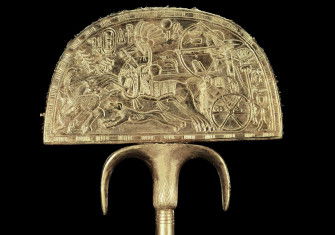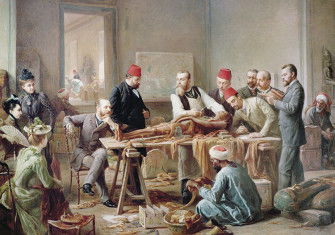Life after Death in Ancient Egypt
Despite the belief of their Pharaohs, not every ancient Egyptian was convinced of the certainty of an eternal afterlife.

Ancient Egypt is commonly believed to have been a society enthralled by the notion of eternal life. Shelley’s Ozymandias, describing an inscription on a shattered, ancient statue, captures this in its coda:
Look on my Works, ye Mighty, and despair!
Nothing beside remains.
Round the decay
Of that colossal Wreck, boundless and bare
The lone and level sands stretch far away.
Ancient Egyptian religion is, in these terms, a naive and narcissistic effort to deny the inexorable predation of time, which strives instead for immortality. This is partly justified. They desiccated their bodies for use in the afterlife and built pyramids – ‘resurrection machines’ – that would ensure the pharaoh had eternal life by transfiguring him into a star, living on in the night sky forever.
Ancient Egyptian literature often suggests a similar ethos. In ‘The Great Hymn to the Aten’, from the reign of the heretic pharaoh Akhenaten (c.1350-35 BC), the pharaoh’s wife Nefertiti is described as ‘living and youthful for ever and ever’. Likewise, the power-crazed ‘Cannibal Hymn’ from the pyramid of the Old Kingdom pharaoh Unas (c.2345-15 BC) reads: ‘The lifetime of Unas is everlasting, his limit is eternity.’ Shelley’s Ozymandias resonates with the student of Ancient Egypt for a reason.
Yet, despite this popular view of the Egyptian afterlife, some Ancient Egyptians were highly ambivalent about such beliefs. Two texts from the Middle Kingdom (c.2050-1710 BC) show that, far from striving blindly towards eternal life, there were those who were engaged in critical, even cynical, religious philosophy and thought. It is telling that such sentiments arose in the Middle Kingdom. Egypt in this period had just emerged from an era of devolved power, fragile central government and intermittent warfare between various Egyptian kingdoms, dynasts and petty warlords. Despite the re-establishment of central power in the Middle Kingdom, a certain fatalism persisted in its literature, which hints at a continued awareness of the dissonance between the invincible pharaoh projected by state propaganda and the relative chaos of the previous epoch.
‘A Dialogue Between a Man and his Soul’ is considered a masterpiece of Egyptian literature. It survives to us on a papyrus and some fragments, probably from the reign of Amenemhat III (c.1860-14 BC). The text takes the form of a disagreement between a man and his ba, an aspect of one’s soul depicted as a human-headed bird that soars between the netherworld and the living world to visit the tombs of the deceased. In an ironic twist, it is the man who yearns for death while his soul argues for life. However, the ability of the dead to return to life in any capacity is scrutinised in the text and left in considerable doubt: ‘Life is a transitory state: trees fall.’
The certainty of the Egyptian mortuary cult, in its pursuit of physical construction as a means of guaranteeing immortality, is thoroughly undermined:
Those who built in granite achieved works – beautiful pyramids, beautiful works – so that their builders should become gods. [Yet] their altars have been destroyed, like the lost [souls] who have perished on the shore for want of an heir, when the waves have taken their toll and the sunlight likewise, to whom [only] the fish at the water’s edge speak.
The anonymous scribe’s assertion of equality in death is profound. The insinuation that death comes to us all and in equal amounts, that departed nobles and pharaohs are the same in death as the pauper, is a radical one. It shows a deep cynicism of the fundamentals of Egyptian funerary religion, explaining that even the most lavish attempts to halt death are, ultimately, futile. However, the scribe does not imply that the afterlife is not real; indeed the concept is somewhat redeemed at the end when man and soul agree to join hands and enjoy both life and death together as partners: ‘I will alight when you are weary, and we will reach harbour together!’
Transcending these declarations of joie de vivre, however, is the sentiment of a harpist’s song, probably meant to be played at funerary rituals, associated with a King Intef (as several Eleventh Dynasty kings bear this name, it is unclear in whose tomb specifically this song would have originally appeared). The language of the surviving copies and the attribution to Intef date it to the end of the First Intermediate Period, when the Theban state was gaining supremacy over its rivals at Hermopolis in the north. The novelty of its thought may be anchored to the novelty of the Theban kingdom: as juvenile pretenders to the title of pharaoh, perhaps old religious orthodoxies were held with less certainty at the Theban court.
Nevertheless, there is initial lip service to traditional religion (‘To perish is a good fate!’) before the scepticism begins to bubble up and the great sages of Egyptian culture are examined: ‘I have heard the words of Imhotep and Hordedef, whose sayings are still recited in their entirety. What of their places? Their walls are in ruins, their places are no more as if they had never existed!’
In other words, afterlife cannot be bought, even by the greatest and the wisest – the winds of time, as in Ozymandias, overcome all. A simple tonic for this problem is offered; to adopt a true carpe diem attitude and ‘Do as your heart commands while you are upon the earth!’ because ‘mourning rescues no man from the netherworld!’
This sentiment strikes us as eerily modern, even relatable. For all the gold and alabaster, the brilliant pyramids and pyres of incense, doubt survived in people’s minds about the validity of it all. ‘The Weary-Hearted [Osiris] hears not their wailing’ says the song – it matters not how hard you pray for the dead, for they are deaf and the underworld is silent. It is difficult to know how unusual such profound scepticism may have been. Yet in these poems one can see individuals doubting, probing, questioning and having their own ideas about the world and the hereafter. The closing refrain of the harpist’s song represents a meditation on death that still bears thinking about today:
Make merry,
Do not weary of it!
Look, no one is allowed to take his possessions with him.
Look, no one who departs returns!
Matthew Chalmers is an Egyptologist and freelance writer.






